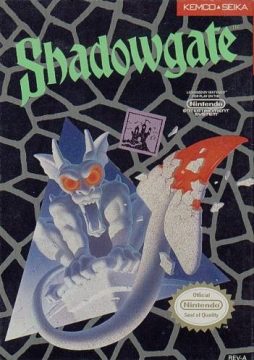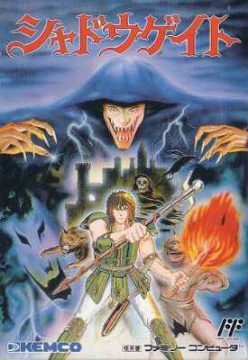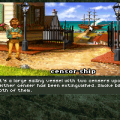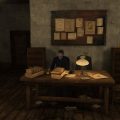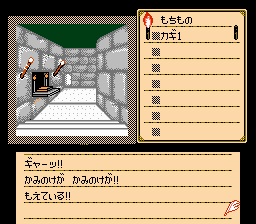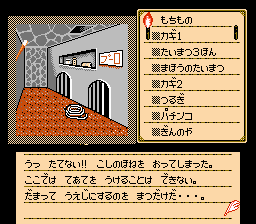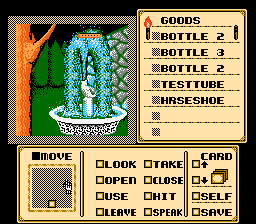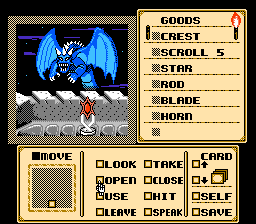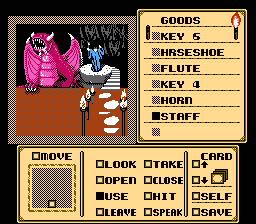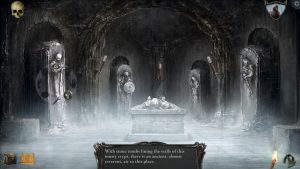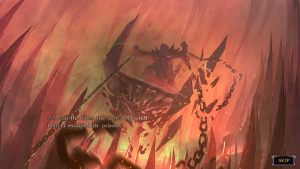The last thing you remember is standing before the wizard Lakmir as he gestured wildly and chanted in an archaic tongue. Now you find yourself staring in an entryway which lies at the edge of a forest. The Druid’s words still ring in your ears: “Within the walls of the Castle Shadowgate lies your quest. If the prophecies hold true, the dreaded Warlock Lord will use his dark magic to raise the Behemoth, the deadliest of the Titans, from the depths of the earth. You are the seed of prophecy, the last of the line of kings, and only you can stop the Warlock Lord from darkening our world FOREVER. Fare thee well.
That’s about all of the story you get in Shadowgate, but that’s all you need – explore a castle, find an ultimate weapon, kill the bad guy, and save the world. Structurally, Shadowgate is most similar to Uninvited, except it takes place in a medieval setting, replacing the haunted mansion with a haunted castle. Despite the similarities, Shadowgate more closely emulates the feeling of crawling further into a dungeon, as the structure is more linear, whereas Uninvited gave you almost free run of the house from the outset. However, there is one spot in Shadowgate where you need to backtrack in order to enter a previously inaccessible area, creating a more unified game world.
There are dozens of obstacles and monsters to overcome, and just as many ways to die. Déjà Vu and Uninvited had plenty of these, but Shadowgate outdoes both of them. Right at the beginning, you will find a book. If you go by your adventure gaming instinct and try to take it, a trap door will open up and send you plummeting to your death. Oops. Instead, you’re supposed to open it and find a key inside. There are tons of tricks and strange oddities littered throughout. There is a cave with a lake, and a skeleton in the middle, holding a key. There is also a shark there. Why a shark? That doesn’t even make sense, them being saltwater dwellers and all.
Later on you’ll find a corridor lined with coffins. Open the wrong one and green ooze will spill over the floor, melting you if you step forward. (Thankfully there’s a way around it.) In one room, you come across three mirrors, one of which hides the door to the next room. Hit the wrong one and you’ll be sucked through a portal into outer space (??) and suffocate. And those aren’t even counting the methods to commit suicide. Try using the torch on yourself, using the axe (or any weapon) on yourself, or stumbling out of any window. The game will let you do most of these, with fairly morbid consequences. The Grim Reaper and his greetings upon your death – “It’s a sad thing that your adventures have ended here!!” – have obtained near legendary status amongst NES fans, who grew frustrated as much as they laughed at the goofiness of it all. The abundant overuse of exclamation points – why use one when you can use two? – makes the writing all the sillier. And despite the appearance of fantasy clichés like ghosts, goblins, dragons and Cyclopes, there’s enough random weirdness that the Castle Shadowgate presents itself as an eclectic funhouse of horrors, filled with bizarre occurrences at nearly every turn.
It’s the strength of the setting that makes Shadowgate as memorable as it is. At one spot, you can try to climb up a ledge to an opening, only to have the ledge crumble. There is no way to reach that door, ever. There are at least a few other locations where exits appear on the map, but there’s no way to actually access them. And when you discover the first dragon, it only appears as a set of blinking eyes at the end of dark hallway, letting out bursts of flame that will roast you if you’re improperly protected. There are many items to be found, and not all of them are useful. There’s a sense of mystery surrounding all of this, the kind that used to provoke awed whispers around the schoolyard. How do you reach that dragon? What does it look like? How do you kill it? How do you actually climb up that broken ledge? The actual answer is, none of it is relevant to your quest, but it makes the castle feel open and real, instead of just some place that exists solely for you to conquer.
Although these aspects make Shadowgate the best of the MacVentures, it still has one particularly annoying issue – torch management. You start the game with a single lit torch, and more are found as you progress. After a certain number of turns, your torch will begin to flicker, and you quickly need to light another one before it goes out completely. If you’re too late, or you’re out of torches, you’ll be lost in the dark and almost immediately killed. (You’re not eaten by a grue, though that would’ve been a fun homage – you just end up stumbling around and breaking your neck, according to the text.)
Beyond this, and the extraordinarily numerous insta-deaths, Shadowgate isn’t terribly difficult. Most of it involves finding and using weapons, or figuring out what to do with stones or talismans, and other puzzles are quite logical. For instance, there’s an item suspended inside of an acid fountain. To reach in, simply put on the gauntlet and take the item. To get the boatman who looks suspiciously like Charon to take you across the river, simply give him a coin. Wanna know how to beat the Hellhound? Throw holy water at it. Some solutions are a bit arbitrary – why do you need to use the spear to kill the troll, when the sword should have worked just as well? – but they rarely get too hard. There’s even one part of the game where you must solve a Sphinx’s riddle by bringing him certain items. The general strangeness of the castle, along with the overwhelmingly silly ways to meet the reaper, have elevated Shadowgate to the level of a classic.
Like the previous MacVenture games, Shadowgate was also ported to the Amiga, Atari ST, IBM PC, and Windows, although there was no Commodore 64 version. The conversions are the same as the others – the Mac version is entirely black and white, the Amiga and Atari ST have full color, the DOS version has awful CGA, and the Windows version is the most modern. Certain versions also let you print out a certificate to prove that you mastered the game. What a cool touch.
Shadowgate was the first MacVenture to be released for the NES in North America. As a huge departure from the usual library of action games known to the audience, the game was an immediate hit. Again, it features 16 color graphics and uses the same interface as Déjà Vu and Uninvited. The text is displayed as if written by a feather quill, a quaint little touch. The writing is a bit simplified, although still relatively violent, and it’s amazing what they were able to sneak past the censors. It even uses the word “hell” a few times – they got away with murder compared to the cuts Maniac Mansion went through a couple of years later. The whole game has an excellent soundtrack, which changes based on your location, and most of it is remarkably catchy – the main theme is undoubtedly one of the most recognizable themes in the NES library. The music even changes when your torch is about to run out, which induces a sense of panic and also helps keep you alive. It’s way too easy to the overlook the cautionary messages in the computer versions.
Like Uninvited, Shadowgate utilizes a “Spell” book to keep track of magic words, which are entered via a text parser in the computer versions. The NES port will also start you back at the prior screen when you die. This is important, because it will also re-light your torch automatically, allowing you to explore for several more turns in hopes that you can find a new one. Although it may result in times where you’re constantly stumbling around and dying, at least you can’t get permanently stuck like in the computer versions.
While most of the puzzles and locations are the same, there are some minor differences. One stems from the lack of a visual inventory – in the computer versions, the “special” torch you need to defeat the wraith is a different color, glows green, and can be lit at anytime. In the NES version, it is simply defined as a “torch”, which for some reason is separated out from all of the normal torches, which are all lumped together in the same slot with a number indicating how many you have. It cannot be lit until you meet the Wraith, so you don’t need to worry about having it burn out. The NES version also introduces one of the funniest death scenes. In the room with the three mirrors, if you use the hammer on the mirror on the left, it will shatter and the glass shards will kill you. (Why this happens to this mirror and not the others, who knows.) In the computer versions, it will crack a tiny bit and leave you unharmed, but destroy the hammer in the process, sticking you in an unwinnable situation.
There was also a location removed from the NES version – an armory, found about halfway through the game, after the Cyclops and across the hallway from the library. This room is filled with goblins and serves no real purpose other than getting you killed, if you dawdle around. It was most likely cut for cartridge space. When you first enter the castle, the eyes of the Warlock Lord appear and taunt you for a bit. This only happens once in the NES version, but happens several times during the course of the adventure in the computer versions.
In 1999, Shadowgate was published on the Game Boy Color, under the name Shadowgate Classic in North America and Europe, and Shadowgate Returns in Japan. It offers support for both the standard Game Boy and the Game Boy Color, and both versions have slightly different graphics. It’s based on the NES version, using the same text, music and puzzles, although the visuals in the Game Boy Color mode are more detailed and colorful. The text window will block the graphic window due to the small size of the screen, and you need to scroll down to select commands or access your inventory.
A version was also released for mobile phones in 2005 by Vatical Entertainment. Although it uses the title of Shadowgate Classic, it uses entirely new graphics once again. The script is adapted too, being more detailed than the NES and Game Boy versions but still missing some stuff from the computer releases. Most of the versions of Shadowgate have identical puzzles and locations, but the mobile version switches things up a bit, removing and adding various things.
A number of the monsters, like the troll, the Cyclops, and the sphinx, are completely gone. Therefore, instead of finding a sword and a sling in the closet at the beginning (items needed to kill the Cyclops), there’s a series of levers which controls the water flow in the castle. You need to use this to get through the waterfall, which you could previously walk right through. One of the underground rooms is now a sewer – the one where you needed to cast a spell on the rope to exit – and instead you need to raise the water to get out. It seems like these are reactions to some of the overdone elements of the original game, although the changes don’t really make this port better, just different.
In 2012, a company named Zojol ran a successful Kickstarter campaign for a remake of Shadowgate, which was released in 2014. Pretty much everything has been redone, with high definition and fully redrawn backgrounds, all of which are brilliant reimaginings of the original’s locales. There’s a revamped interface that reduces the clutter of the original, and a brand new orchestrated soundtrack. Yet it offers some optional elements for fans of the NES game, including the original 8-bit soundtrack, the swirling screen transitions, and the little feathered pen that writes the text. There’s a “retro” visual option too, though it just heavily pixelated the new visuals rather than using the old ones. However, at the time of the remake’s release, Zojol did also re-release both the Macintosh and Apple IIgs versions of the game along with it, so you can still experience the original version.
Rather than simply remake the game, much of the structure has been overhauled and the story expanded. The skull at the beginning can talk and provides both flavor commentary and acts as an optional hint system. There’s a new introduction scene that shows the adventurer’s trek to the the castle, plus there are some obelisks around that, when activated, will trigger a cutscene of Lakmir delivering instructions to the main character, now referred to in-game as Jair Cuthegar. Many locations will seem familiar but some are new, and various puzzles have been changed around, added, or replaced, some of which are similar to the expanded mobile version.
There are three difficulty settings, with different puzzles. The normal difficulty, “Journeyman”, is about on par with the original game, and the hard mode, “Master”, even more difficult, with many more items to juggle. The easy mode, “Apprentice”, basically removes the need for torches and removes many of the insta-deaths, though they’ll all still play tricks on people that are too familiar with the original versions. Many scrolls have been added, which provides hints and add a bit to the story. There are different elementals to catch, some in ways that are similar to the original game. For example, you no longer just through the sphere into the lake to freeze it – instead, you use an orb to capture an ice elemental, and then use it like that. Near the beginning of the game, you get cursed by a banshee, and need to cure yourself before it kills you. There’s also an added Halloween-themed story regarding pumpkins.
Even though the new interface is cleaner, is still feels a little clunky, especially when using items. There’s a map, but no way to see the exits in the room anymore. But other than that, this is an excellent remake, one which respects and expands the original, and provides a new challenge to longtime fans.
The Famicom version of Shadowgate is well known amongst the Japanese retro gaming community for its rather silly writing. While the English version was written in the second person, like most text adventures, the Japanese version is written in the first person, which sounds pretty ridiculous. Take, for instance, the death message. In English it reads “It’s a sad thing that your adventures have ended here!!”, while in Japanese, it’s something like “How unfortunate! My adventure has ended here!!” It was sort of cool in English since the Grim Reaper was supposed to be taunting you, but in Japanese it sounds like some crazy dead guy is lamenting pointlessly to himself. That translation was pretty close, at least – many of the overwrought death messages were rewritten to sound even more absurd than they originally were.
(After using your torch on yourself three times):
English: You finally set your hair on fire. The rest of your body soon follows!!
Japanese: Yaagghh!! My hair, my hair!! It’s burning!! The burns spread across my body!! I writhe in pain as I breathe my last.
(After using your sword on yourself):
English: You thrust sword [sic] into your chest!! Blood begins to flow!! Suicide won’t help in your quest!! The Warlock Lord will surely triumph now!!
Japanese: I thrust the sword’s blade into my left breast. … Blood pours out of the wound!! Ahhh!! How could I be so foolish? I took my own life, with my own hand!! … The world will surely be cloaked in darkness after I die…
(After attempting to defeat a Cyclops with your bare hands):
English: A battle cry dies in your throat, as the Cyclops crushes your skull with his club.
Japanese: Quicker than I could attack, the club descends upon my head!! My head has been cracked open!!
(After jumping out many of the game’s windows):
English: With a cry you jump to your death!! It takes only a couple of seconds before you hit the bottom with a thud.
Japanese: I scream in vain as my body floats in the air!! As I spin, various disconnected thoughts pass through my mind. The last thing I saw was a twinkling star, shining its eerie light in the midst of darkness.
(After awakening the chained female werewolf):
English: With a loud roar, the wolf pounces on you, taking your life!! The wolfs [sic] powerful jaws rip your throat out!!
Japanese: Agghh!! The woman transformed instantly into a wild, ferocious wolf. It’s angry!! It’s attacking!! Ahhh!! I’m done for!! Arrghh!! The wolf’s fangs glint in the light, and at that instant, I became the werewolf’s latest meal.

